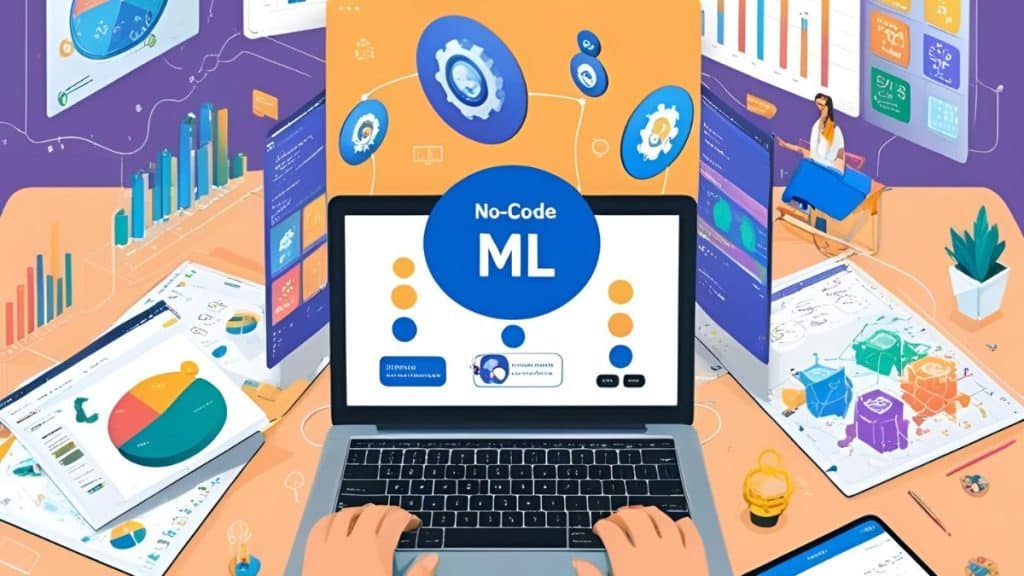It’s difficult to find data scientists in a world that’s growing more dependent on data. That’s where how machine learning automation can help.
The world faces an acute shortage of data scientists. In 2016, there were over 1700 data scientist job vacancies on Glassdoor, and in 2020, there were over 6500. This glaring gap is only set to grow further. IBM analysts and the US Bureau of Labor Statistics predict a 28% increase over the next five years. Automated machine learning is a key growth area in the world of business, commerce, and more.
If you’re wondering why there’s such a huge unmet demand, the answer is anything but simple.
The Shortage of Data Scientists in 2022
Research from Quanthub summarizes that there are not enough data scientists. The job postings outnumber the job searches threefold.
According to The Quant Crunch, job openings for data scientists were 100k+ in 2021. Companies offered great incentives to applying data scientists. Yet the quantum of big data projects far outweighed suitable candidates. Suitable candidates needed to have the required skill set to handle the data.
There are similar trends and findings for 2022 too. A large number of data science jobs point to the increasing demand. Career opportutnities for big data and analytics professionals grow every day. This further drives the need for distinctive skill sets. Data is being used to create massive change in many industries. There is not an industry left untouched. That includes healthcare, finance, marketing, business, retail, eCommerce, SaaS.
This does not mean that there won’t be some improvement in the availability of data scientists. The ratio between the number of data scientists and the big data need remains too big.
Why? The need for skilled data professionals continues to grow. Companies work towards improving their efforts concerning big data. They do this as they attempt to simplify their business models. Businesses continue to seek out revenue opportunities in the digital sphere.
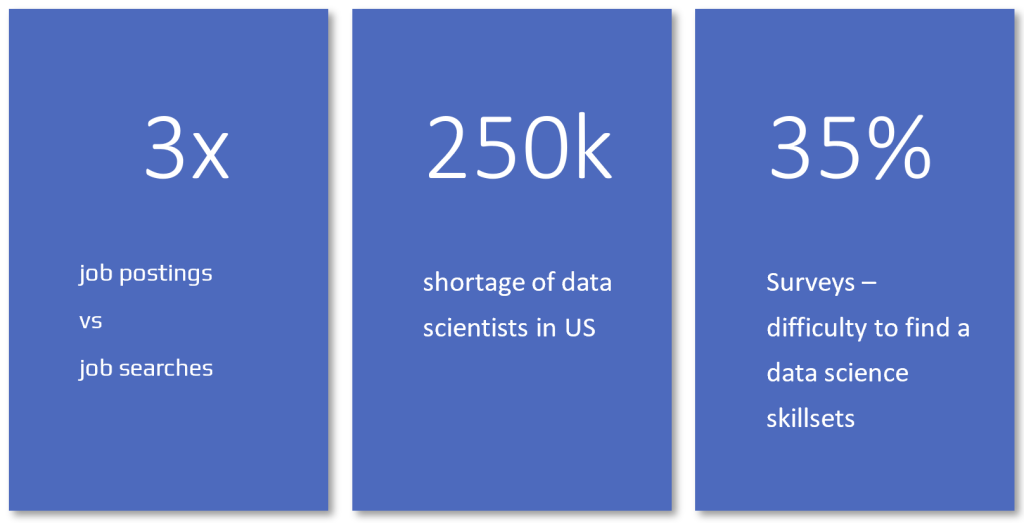
Smaller businesses are beginning to employ specialists. SMEs have come to understand how vital data analysis is in helping their brand grow. There are other factors such as lack of appropriate education and guidance. The situation compounds further as there is rapid technological advancement. There is a demand for new skill sets, every day. These include understanding ML, data visualization, and knowledge of advanced statistical tools.
While data analysts can be found , they lack skills comparable to data scientists.
Data Scientist vs. Data Analyst
There are big differences between a Data Analyst and a Data Scientist. A Data Analyst translates available data into common language. A Data Analyst provides clear and concise insights.
A Data Scientist analyzes actionable insights. A Data Scientist creates models using machine learning and advanced SQL.
Data Scientists are often required to use the following technical skills:
- Python programming / R programming.
- Advanced SQL.
- Machine Learning and AI.
These skills are fairly uncommon amongst Data Analysts. They are already required to do a lot of tedious work which involves:
- Inspecting and cleaning data to reveal crucial insights
- Identifying correlations or patterns and statistically analyzing or mining data
- Visualizing data to interpret and present findings in a comprehensive manner
Data analysts are more focused on studying large amounts of data. Data Analysts then interpret the data, and answer questions or solve problems.
Though often used interchangeably, both jobs have extremely different roles. The scarcity of Data Scientists might affect the work of Data Analysts.
The solution is simple. Automate a Data Scientist’s contribution to handling data for specific jobs.
Let’s look at how automation and no-code ML can tackle the scarcity of Data Scientists.
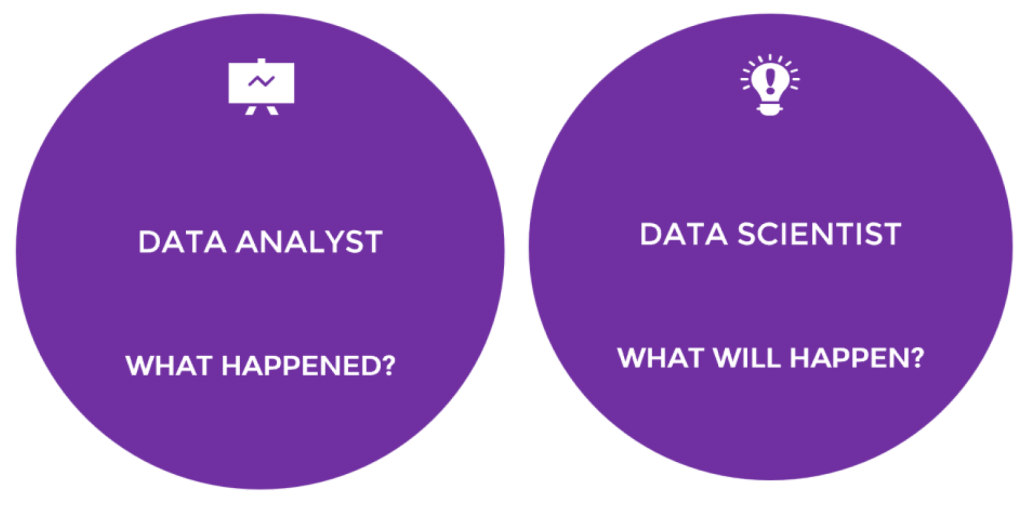
Data Analysts Turned Data Scientists
Machine learning and artificial intelligence are now commonplace. Most data analysts lack the technical skills that data scientists have. While BI is picking up, data analysts might struggle to keep up. Businesses need to continue to hunt for data scientists.
This might seem discouraging. It is, however, an incredible opportunity for data analysts to recover their position. And they don’t need the formal training of a data scientist.
It is a unique situation to be in. The experience as a data analyst puts you in a novel position to effectively blend BI with ML. You can use your existing knowledge by using the right software. This doesn’t have to be complicated. Automated machine learning will provide you with the tools.
You can use ready tools for advanced diagnostic analytics, predictive and prescriptive calculations. This bridges the gap between the market’s need for data scientists and the skills you can offer.
Tackling The Lack of Data Scientists
To fix the problem of too few data scientists: Automation and no-code Machine Learning (ML) are the most obvious answers.
Here’s a closer look at why.
An article studying how automation might take over jobs that require repetitive actions, lack creativity or a high social IQ, and do not require much training, shows interesting statistics for automated jobs.
Further, The Fourth Age: Smart Robots, Conscious Computers, and the Future of Humanity, Byron Reese lays out the characteristics of jobs at high risk for automation.
These are:
- Repetitive: either physically or mentally.
- Low creativity: no need for improvisation and novel ways of thinking.
- Low social IQ: no communication, persuasion, or charisma required.
- Limited training: the ease of automating a job is inversely proportional to the length of a “manual” it would take to fully describe that job.
Why Machine Learning Automation?
Mastering how to code well enough to be proficient in the technical aspects required for automated machine learning and artificial intelligence can take years. Even the most seasoned programmers struggle with the process, so it’s not surprising that data analysts lack the skills to do so.
After all, the time and effort to learn how to program and code effectively is extremely high. Even then, it can take months to make an automation model that is effective and functional.
Therefore, no-code machine learning is the answer to solving all kinds of automation issues. Wondering why? Simple. They allow analysts to make predictions and work with available data at a much quicker pace without requiring a higher budget for resources involved in employing data scientists.
Therefore, data analysts can be creative and proactive and utilize their skills better with no-code machine learning at hand.
To understand this better, we can look at traditional machine learning and how it differs from no-code machine learning.
What is Traditional Machine Learning
This image gives a basic idea of what goes into traditional machine learning.
the traditional machine learning process
Essentially, this type of Artificial Intelligence (AI) enables applications to accurately predict outcomes even though they may not be explicitly programmed to do so.
The algorithms employed in machine learning use historical data input to produce the output values.
The four basic approaches to machine learning are:

- Supervised learning – In which both the input and output variables of the algorithm are specified.
- Unsupervised Learning – The algorithm in this type of machine is trained on unlabeled data, and the data input and predicted outputs are predetermined.
- Semi-supervised Learning – This is a mix of supervised and unsupervised models, and the training data may be labeled, but the model can freely explore the data on its own.
- Reinforcement Learning – This model teaches a machine to complete multi-step processes with clearly defined rules.
Traditional Machine Learning is often used in:
- Customer relationship management (CRM) software
- Business intelligence and analytics
- Human Resource Information Systems
- Self-driving cars
- Virtual assistants
Essentially, this type of Artificial Intelligence (AI) enables applications to accurately predict outcomes even though they may not be explicitly programmed to do so.
The algorithms employed in machine learning use historical data input to produce the output values.
The four basic approaches to machine learning are:
- Supervised learning – In which both the input and output variables of the algorithm are specified.
- Unsupervised Learning – The algorithm in this type of machine is trained on unlabeled data, and the data input and predicted outputs are predetermined.
- Semi-supervised Learning – This is a mix of supervised and unsupervised models, and the training data may be labeled, but the model can freely explore the data on its own.
- Reinforcement Learning – This model teaches a machine to complete multi-step processes with clearly defined rules.
Traditional Machine Learning is often used in:
- Customer relationship management (CRM) software
- Business intelligence and analytics
- Human Resource Information Systems
- Self-driving cars
- Virtual assistants
What is Machine Learning Automation
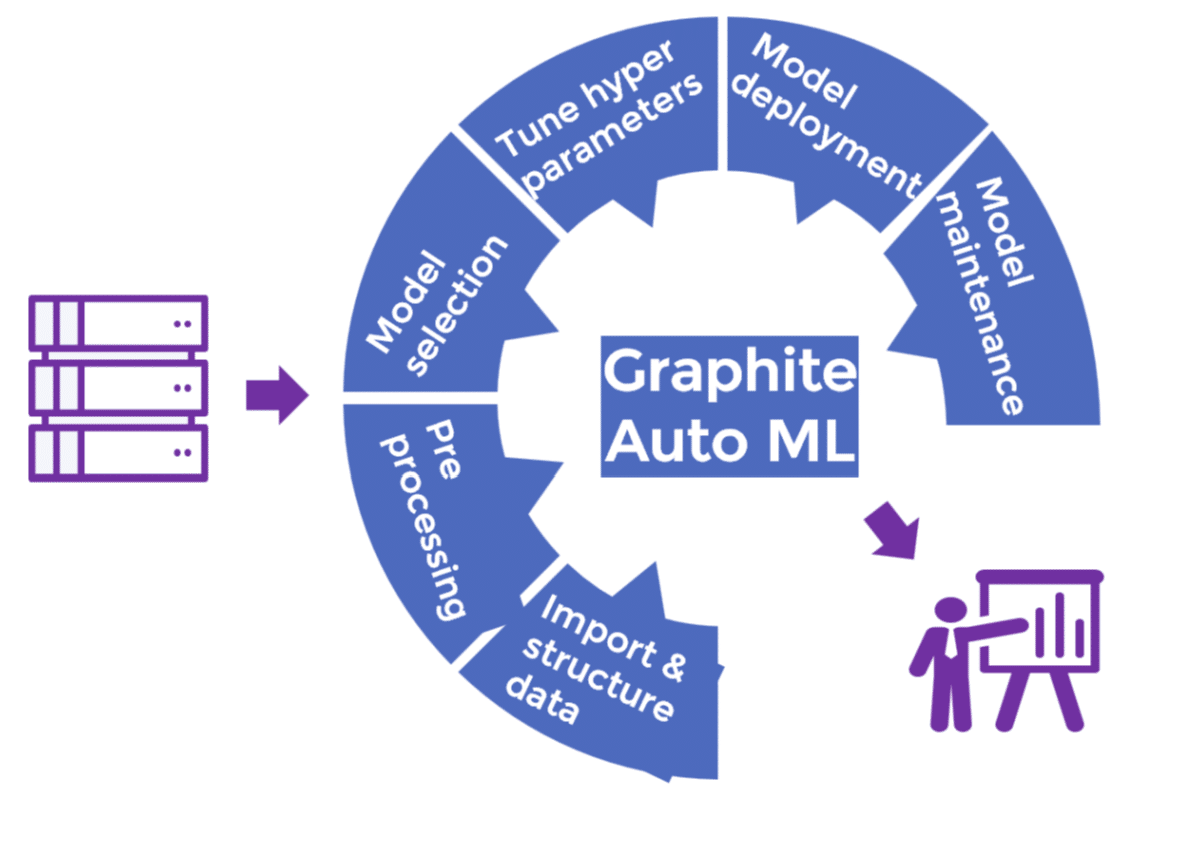
As seen in the image above, no-code machine learning is evidently a much simpler process. An automated machine learning tool makes it far easier to integrate AI into your operations.
In automated ML, all repetitive processes are automated:
- Import data
- Preprocessing
- Feature engineering
- Feature selection
- Feature transformation
- Missing values
- Outlier handling
- Numerous checks
- Model selection
- Choosing the best model based on model scoring for the dataset
- Model assessment
- Tune model hyper-parameters
- Model deployment, so it can be used by team members
- Model maintenance
No-code machine learning is ta drastically simpler process for making data predictions and does not require too many technical skills. An automated machine learning tool, like Graphite Note, helps you manage machine learning tasks, without needing to know how to code.
No-code machine learning enables data analysts to build applications and systems without requiring any conventional programming knowledge or software. It is accessible through visual interference and guided actions, along with pre-built integrations that allow the user to exchange information however required.
When speaking about the no-code machine learning and machine learning applications, Alphabet’s growth fund CapitalG, Alex Nicholas, said, “No code is empowering business users to take over functionality previously owned by technical users by abstracting complexity and centering around a visual workflow. This profound generational shift has the power to touch every software market and every user across the enterprise.”
Some of the best no-code machine learning tools allow easy drag-and-drop predictions that make editing queries extremely simple. Users must thus only replace identifiers and prediction columns and ignore those they do not wish to use.
This also reduces the time taken to create predictions to a few minutes!
The doing-away of technical computing programs has certain undeniable benefits. Machine learning applications and machine learning solutions help your business in many ways:
● You can embed a data-driven ethos without allocating resources for a data science team.
● It is far more feasible to create and scale machine learning driven products.
● Improve decision-making based on facts and projections, using machine learning methods.
● Reduction in cost and improving profit margins, while integrating a machine learning model that helps you build your business.
Data analysts can receive deeper insights into key business drivers through Graphite Note’s no-code machine learning-generated insights, which use proven machine learning model templates.
The software can also help expand the data analytics teams’ augmented and predictive analytic skills and tap into their full potential to make predictions based on available data.
Moreover, Graphite Note makes it extremely simple for analysts to use AI, machine learning tools, and machine learning methods, for business analytics. It also allows users to generate a machine learning model, or machine learning models, without coding or programming knowledge.
Graphite Note is automated to handle machine learning tasks and build models by selecting a machine learning algorithm that produces and explains results as a data scientist would.
Graphite Note also has certain crucial data storytelling features, as premium machine learning applications should. Why is this such an essential offering?
The Importance Of Data Storytelling
Data storytelling converts complex data into easily comprehensible stories that can be read and shared. It essentially presents information in a clear, concise, and readable manner, allowing you to understand crucial details and insights regarding your business.
Graphite Note data story
A data storytelling program is extremely beneficial to make the jobs of data analysts simpler and more effective.
Here are some of the key aspects in which data storytelling acts as a solution to the complexities caused by big datasets:
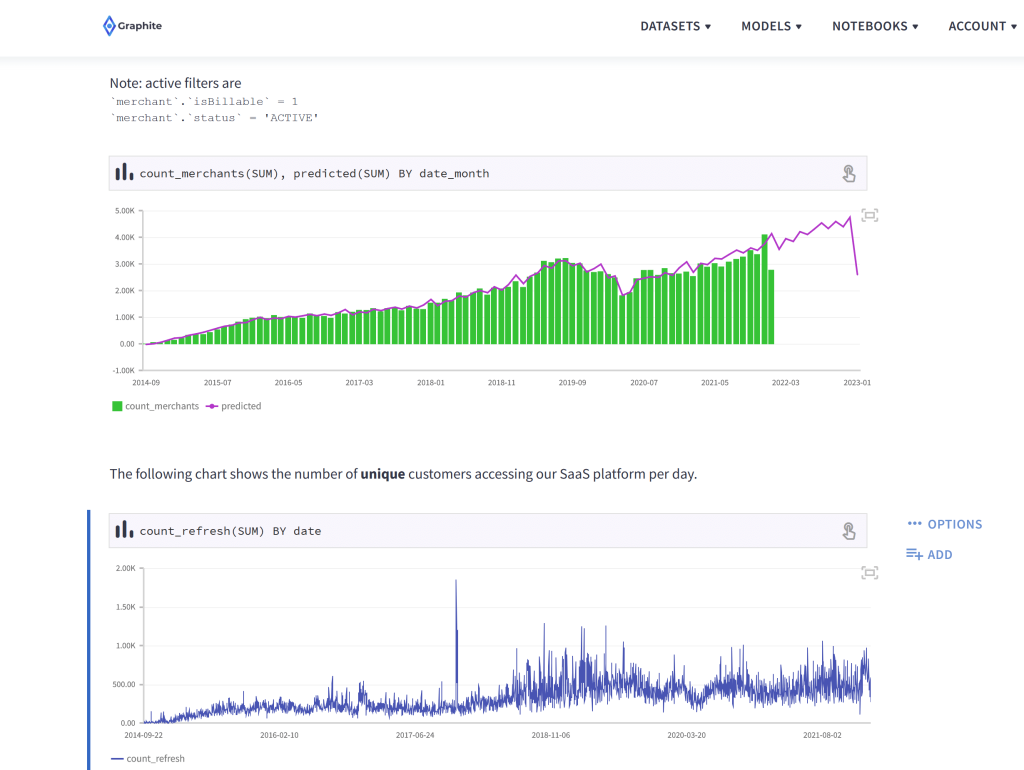
● Converts metrics into insights
● Assists with enhancing engagement and communication
● Helps visualize narratives
● Provides a simple basis for complex explanations
Roger C Schank, a cognitive scientist, states that “Humans are not ideally set up to understand logic; they are set up to understand stories.”
This is essentially what data storytelling is meant for – to make data easier to understand.
Here are some essential features for an effective data storytelling solution that Graphite employs:
● Human-friendly visuals that are easy to understand and comprehend at a glance
● Easy integration of text and visuals
● A narrative flow of information and data
● Ability to connect and save essential bits of data
● Tools to share and collaborate on datasets
Data storytelling, thus, transforms data from a database’s impartial fields into opinions, arguments, and insights. With the required tools, data analysts can perform more engaging and meaningful data storytelling and, as a result, get a higher return on their investment if data culture is elevated and the education on digital literacy across the board is improved.
This is exactly what Graphite Note aims to do!
Conclusion
Data scientists play an important role in data analytics. However, with the shortage of skilled data scientists, it is only a matter of time before automation technology advances enough to bridge this gap.
Software platforms like Graphite Note are ideal for instances where no-code machine learning can automate data scientists’ jobs.
Why? Because no-code machine learning is the simplest way to empower data analysts in all spheres of business and with all kinds of backgrounds to work with machine learning.
While BI and analytics platforms exist to help organizations understand the reason behind certain things happening, Graphite helps users understand what is expected to happen and how they can prepare and deal with it.
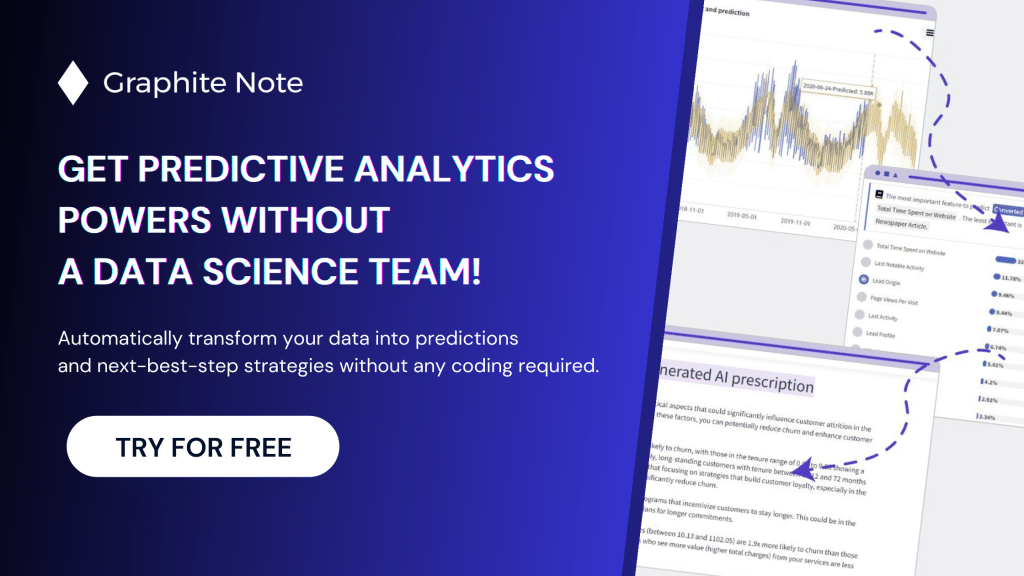
Graphite also helps simplify the use of AI and machine learning in business analytics, thus assisting users in generating machine learning models without coding or programming-related skills. Its explainable AI enables everyday business users to work with their data efficiently.In addition to its optimized ML algorithm, its data storytelling features are also changing the game. In short – “how to spend less time explaining to your colleagues what’s happening, over and over again.”

